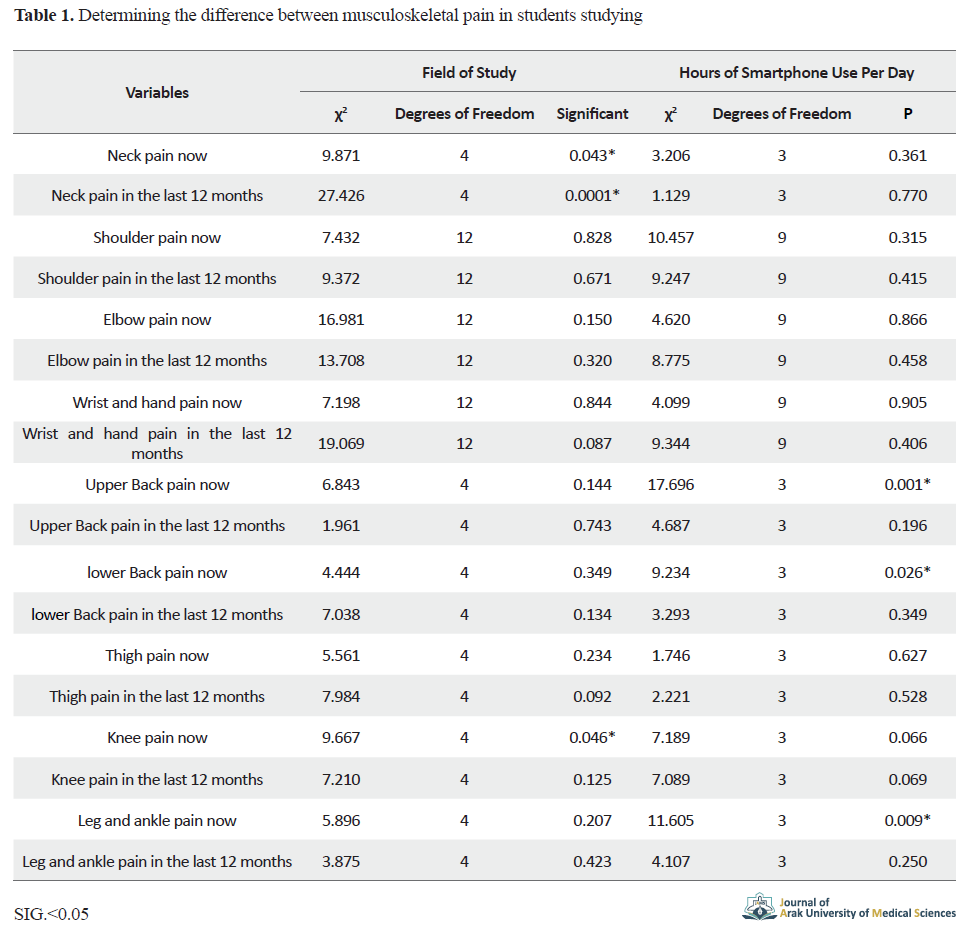BibTeX | RIS | EndNote | Medlars | ProCite | Reference Manager | RefWorks
Send citation to:
URL: http://jams.arakmu.ac.ir/article-1-6224-en.html
2- Department of Occupational Therapy, School of Rehabilitation, Tehran University of Medical Sciences, Tehran, Iran. ,
3- Department of Occupational Health Engineering, School of Health, Arak University of Medical Sciences, Arak, Iran.
4- Department of Neurology, School of Medicine, Amiralmomenin Hospital, Arak University of Medical Sciences, Arak, Iran.
5- Department of Biostatistics and Epidemiology, School of Health, Scientific Research Center, Tehran University of Medical Sciences, Tehran, Iran.
1. Introduction
he most prevalent musculoskeletal disorder is musculoskeletal pain. Economically, they are in first place in imposing medical expenses [2]. Numerous studies have shown that students are among society’s sections exposed to musculoskeletal pain [4-8]. Musculoskeletal pain is relatively higher in students, especially students who are in direct contact with patients. Students as a productive and young part of society, and they are expected to perform various activities. Thus, it seems necessary to pay more attention to musculoskeletal problems among them. The present study aimed to determine the prevalence of musculoskeletal pain in students in the schools of rehabilitation, dentistry, and nursing of Arak University of Medical Sciences (Arak MU) in 2018-2019.
2. Materials and Methods
This study was a cross - sectional descriptive study. five - hundred and thirty eight students from the rehabilitation, nursing and dentistry schools of Arak UM wee recruited using the convenience sampling approach in 2018-2019 who were willing to participate in the study. Inclusion criteria included a male or female student in Rehabilitation, Dentistry, and Nursing schools of Arak MU, no student suffering from inherited or underlying diseases and the student’s age between 18-40 years. Data collection tools in this study were the demographic questionnaire and the Nordic questionnaire. Finally, the prevalence of musculoskeletal pain was calculated by gender, age, study field, and students’ academic year and was reported based on percentage. Statistical data analysis was performed using SPSS V. 18.
3. Results
In this study, 538 students (205 males and 333 females) were assessed that Mean±SD age was 22.04±2.53 years, Mean±SD height was 169.99±9.9 cm, and Mean±SD weight was 65.28±13.51 kg. Of them, 327 (61%) students were using computer for 7 years and more and 383 (71.2%) used a laptop. The results of the study showed that the prevalence of musculoskeletal pain in the spine (neck 29.4%, upper back 24.3%, and lower back 37.2%) is higher than the upper and lower extremities.
And the highest rate of musculoskeletal pain were related to the lower back, neck, and upper back, respectively. The highest prevalence of musculoskeletal pain in the upper extremities were 12.8% in the right wrist and right hand, 9.5% in the right shoulder, 6.9% in both shoulders, 3.4% in both wrists and hands, and 3.3% in the right elbow, respectively and in the lower extremities the highest prevalence of musculoskeletal pain was 18.8% in the knee, 10.2% in the ankle and foot, and 8.4% in the thigh, respectively. Musculoskeletal pain in the shoulder, upper back, lower back, and thigh showed a significant difference based on gender, and musculoskeletal pain in the neck, ankle, and foot showed a significant difference based on age (P<0.05). Musculoskeletal pain in the neck and knees based on the field of study (P<0.05) and musculoskeletal pain in the back and ankle based on the hours of smartphone use per day showed a significant difference (Table 1).

4. Discussion and Conclusion
The results of the present study showed that the prevalence of musculoskeletal pain in the spine was higher than in the upper and lower extremities, and the highest prevalence of musculoskeletal pain was related to the lower back. These results are consistent with the results of previous studies [7, 12, 13]. The highest prevalence of musculoskeletal pain in students was reported in the low back region (80%) [12].
In this study, about one-third of students reported neck pain, which is consistent with previous research among Japanese and American nurses, and neck pain is the most common musculoskeletal disorder after low back pain [14, 15]. However, in our study, no significant difference was reported between musculoskeletal disorders and smartphone use. One reason may be related to methodological issues such as statistical accuracy.
A significant difference was observed between age and the prevalence of musculoskeletal pain in the neck, ankle, and foot. It may be a sign of a change in students’ health behavior [22], which potentially affects the development of musculoskeletal pain. Musculoskeletal pain in the upper back and low back also showed a significant difference based on smartphone use hours per day. A 5-year cohort study was conducted to investigate typing a message on a mobile phone and its effect on musculoskeletal disorders in young people aged 20-24 years. It was found that there is a relationship between persistent neck and back pain and typing [24].
The results of this study suggested that students in the fields of rehabilitation, nursing, and dentistry are exposed to musculoskeletal pain, especially in the lower back, cervical, and upper back. However, no relationship was found between musculoskeletal pain and computer use, and it is suggested to investigate the relationship between skeletal pain and computer use.
Ethical Considerations
Compliance with ethical guidelines
The Ethics Committee of Arak University of Medical Sciences approved this research (Code: IR.ARAKMU.REC.2018.253).
Funding
This article was extracted from a research project (Code: 3047) of Arak University of Medical Sciences.
Authors' contributions
All authors met the standard writing criteria based on the recommendations of the International Committee of Medical Journal Publishers (ICMJE) and all contributed equally to the writing of the work.
Conflicts of interest
The authors declared no conflict of interest.
Acknowledgements
We thank the Vice-Chancellor for Research and Technology of Arak University of Medical Sciences to approve and finance this project.
| Rights and permissions | |
 |
This work is licensed under a Creative Commons Attribution-NonCommercial 4.0 International License. |









